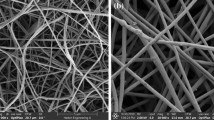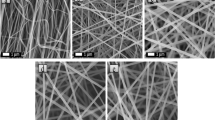Abstract
This study focuses on the synthesis of carbon nanotubes decorated with nickel-zinc ferrites and fabrication of polyurethane (PU) nanofiber containing CNT-ferrite composites as highly efficient adsorbents for removal of hydrogen sulfide. Scanning electron microscopy (SEM), transmission electron microscopy (TEM), Fourier transformed infrared (FTIR) spectroscopy, and powder X-ray diffraction (PXRD) are used to perform microstructural and morphological characterization of the electrospun nanofibrous composites. To show the efficiency of the composite as an adsorbent, a breakthrough test is carried out. It is shown that the PU-CNT-ferrite composites are fabricated almost uniformly with an average fiber diameter of 320 nm and exhibit significant H2S breakthrough capacity (498 mgH2S/g) compared to both the pristine PU and PU-CNT nanofibers. These electrospun nanofibers based on CNT-ferrite composites, already studied for H2S adsorption with promising results, open up new and interesting perspective into the design and fabrication of highly efficient membrane for practical application in the processes of air purification.








Similar content being viewed by others
References
Abatzoglou N, Braidy N, Hu Y (2015) Carbon nano filaments functionalized with iron oxide nanoparticles for in-depth hydrogen sulfide adsorption. Ind Eng Chem Res 54(37):9230–9237
Arcibar-orozco JA, Wallace R, Mitchell JK, Bandosz TJ (2015) Role of surface chemistry and morphology in the reactive adsorption of H2S on iron (hydr)oxide/graphite oxide composites. Langmuir 31(9):2730–2742
Bagreev A, Bandosz TJ (2000) Study of H2S adsorption and water regeneration of spent coconut-based activated carbon. Environ Sci Technol 34(21):4587–4592
Bagreev A, Bandosz TJ (2001) H2S adsorption / oxidation on unmodified activated carbons : importance of prehumidification. Carbon 39:2303–2311
Bahgat M, Farghali A, El Rouby WMA (2013) Adsorption of methyl green dye onto multi-walled carbon nanotubes decorated with Ni nanoferrite. Appl Nanosci 3(3):251–261
Bajaj B, Joh H-I, Jo SM, Park JH, Yi KB, Lee S (2018) Enhanced reactive H 2 S adsorption using carbon nanofibers supported with Cu / Cu x O nanoparticles. Appl Surf Sci 429:253–257. https://doi.org/10.1016/j.apsusc.2017.06.280
Budd MAXS, Bewick HOW (1952) Photometric determination of sulfide and reducible sulfur in alkalies. Anal Chem 24(10):1536–1540
Cao H, Zhu M, Li Y, Liu J, Ni Z, Qin Z (2007) A highly coercive carbon nanotube coated with precipitation – hydrothermal process. J Solid State Chem 180:3218–3223
Daneshyar A, Ghaedi M, Sabzehmeidani MM, Daneshyar A (2017) H2S adsorption onto Cu-Zn–Ni nanoparticles loaded activated carbon and Ni-Co nanoparticles loaded c -Al 2 O 3 : optimization and adsorption isotherms. J Colloid Interface Sci 490:553–561. https://doi.org/10.1016/j.jcis.2016.11.068
Dehghan SF, Golbabaei F, Maddah B, Latifi M, Pezeshk H, Hasanzadeh M, Akbar-Khanzadeh F (2016) Optimization of electrospinning parameters for polyacrylonitrile-MgO nanofibers applied in air filtration. J Air Waste Manag Assoc 66(9):912–921
Demir A, Baykal A, Sözeri H, Topkaya R (2014) Low temperature magnetic investigation of Fe 3 O 4 nanoparticles filled into multiwalled carbon nanotubes. Synth Met 187:75–80. https://doi.org/10.1016/j.synthmet.2013.10.027
Dong W, Wang D, Wang H, Li M, Chen F, Jia F, Yang Q, Li X, Yuan X, Gong J, Li H, Ye J (2019) Facile synthesis of in 2 S 3 / UiO-66 composite with enhanced adsorption performance and photocatalytic activity for the removal of tetracycline under visible light irradiation. J Colloid Interface Sci 535:444–457. https://doi.org/10.1016/j.jcis.2018.10.008
Ensafi AA, Rezaei B, Allafchian AR (2013) Simultaneous determination of guanine and adenine in DNA based on NiFe 2 O 4 magnetic nanoparticles decorated MWCNTs as a novel electrochemical sensor using adsorptive stripping voltammetry. Sensors Actuators B Chem 177:634–642. https://doi.org/10.1016/j.snb.2012.11.028
Faye O, Raj A, Mittal V, Chedikh A (2016) H2S adsorption on graphene in the presence of sulfur : a density functional theory study. Comput Mater Sci 117:110–119. https://doi.org/10.1016/j.commatsci.2016.01.034
Faye O, Eduok U, Szpunar J (2018) H2S adsorption and dissociation on NH-decorated graphene: a first principles study. Surf Sci 668:100–106. https://doi.org/10.1016/j.susc.2017.10.016
Geng Q, Wang L-J, Yang C, Zhang H-Y, Zhao Y-R, Fan H-L, Huo C (2019) Room-temperature hydrogen sulfide removal with zinc oxide nanoparticle / molecular sieve prepared by melt infiltration. Fuel Process Technol 185(September 2018):26–37. https://doi.org/10.1016/j.fuproc.2018.11.013
Ghorbel A, Chekir H, Trabelsi N, Khemakhem S (2016) Properties of modified crude clay by iron and copper nanoparticles as potential hydrogen sulfide adsorption. Appl Clay Sci 128:123–128
Hou W, Zhao N-J, Meng D, Tang J, Zeng Y, Wu Y, Weng Y, Cheng C, Xu X, Li Y, Zhang J-P, Huang Y, Bielawski CW, Geng J (2016) Controlled growth of well-defined conjugated polymers from the surfaces of multiwalled carbon nanotubes: photoresponse enhancement via charge separation. ACS Nano 10(5):5189–5198
Huang C-c, Chen C-h, Chu S-m (2006) Effect of moisture on H2S adsorption by copper impregnated activated carbon. J Hazard Mater 136(3):866–873. https://doi.org/10.1016/j.jhazmat.2006.01.025
Hull M, Liu R, Rodriguez R, Mazyck D (2018) Impregnating activated carbon with iron salts to increase hydrogen sulfide removal. UF J Undergrad Res 20(2). https://doi.org/10.32473/ufjur.v20i2.106174
Ikenaga N-o, Chiyoda N, Matsushima H, Suzuki T (2002) Preparation of activated carbon-supported ferrite for absorbent of hydrogen Sul ® de at a low temperature Q. Fuel 81:1569–1576
Jafarian M, Afghahi SSS, Atassi Y, Salehi M (2019) Insights on the design of a novel multicomponent microwave absorber based on SrFe10Al2O19 and Ni0.5Zn0.5Fe2O4/MWCNTs/polypyrrole. J Magn Magn Mater 471(May 2018):30–38. https://doi.org/10.1016/j.jmmm.2018.09.047
Janetaisong P, Lailuck V, Supasitmongkol S (2017) Pelletization of iron oxide based sorbents for hydrogen sulfide removal. Key Eng Mater 751:449–454. https://doi.org/10.4028/www.scientific.net/KEM.751.449
Kim A J-h et al (2019) Enhancement of H2S sensing performance of P-CuO nanofibers by loading p-reduced graphene oxide nanosheets. Sensors Actuators B Chem 281:453–461. https://doi.org/10.1016/j.snb.2018.10.144
Lee S, Kim D, Lee S, Kim D (2019) Enhanced adsorptive removal of hydrogen sulfide from gas stream with zinc-iron hydroxide at room temperature. Chem Eng J 363:43–48. https://doi.org/10.1016/j.cej.2019.01.122
Ling K, Gangoli VS, Barron AR (2019) Synergic adsorption of H2S using high surface area iron oxide-carbon composites at room temperature. Energy Fuel 33:7509–7521
Maat H, Hogendoorn JA, Versteeg GF (2005) The removal of hydrogen sulfide from gas streams using an aqueous metal sulfate absorbent Part II . The regeneration of copper sulfide to copper oxide — an experimental study. Sep Purif Technol 43:199–213
Maddah B, Chamani H, Hasanzadeh M (2017) On the hydrogen cyanide removal from air using metal loaded polyacrylonitrile composite nanofibers. J Chem Health Risks 7(4):303–315
Magnone E, Dong S, Hoon J (2018) A systematic study of the iron hydroxide-based adsorbent for removal of hydrogen sulphide from biogas. Microporous Mesoporous Mater 270(May):155–160. https://doi.org/10.1016/j.micromeso.2018.05.018
Marchelli F, Cordioli E, Patuzzi F, Sisani E, Barelli L, Baratieri M, Arato E, Bosio B (2019) Experimental study on H2S adsorption on gasification char under different operative conditions. Biomass Bioenergy 126(April):106–116. https://doi.org/10.1016/j.biombioe.2019.05.003
Mochizuki T, Kubota M, Matsuda H, Elia LFD (2016) Adsorption behaviors of ammonia and hydrogen sulfide on activated carbon prepared from petroleum coke by KOH chemical activation. Fuel Process Technol 144:164–169. https://doi.org/10.1016/j.fuproc.2015.12.012
Mohamadalizadeh A, Towfighi J, Rashidi A, Mohajeri A, Golkar M (2011) Modification of carbon nanotubes for H 2 S sorption. Ind Eng Chem Res 50:8050–8057
Nakamura R, Lee JG, Tokozakura D, Mori H, Nakajima H (2007) Formation of hollow ZnO through low-temperature oxidation of Zn nanoparticles. Mater Lett 61:1060–1063
Nguyen-thanh D, Block K, Bandosz TJ (2005) Adsorption of hydrogen sulfide on montmorillonites modified with iron. Chemosphere 59:343–353
Ning P, Liu S, Wang C, Li K, Sun X, Tang L, Liu G (2018) Adsorption-oxidation of hydrogen sulfide on Fe/walnut-shell activated carbon surface modified by NH3-plasma. J Environ Sci 64:216–226. https://doi.org/10.1016/j.jes.2017.06.017
Radoń A, Łukowiec D (2019) The structure and formation mechanism of FeS2 /Fe3 S4 /S8 nanocomposite synthesized using spherical shaped Fe3 O4 nanoparticles as the precursor. Int J Mater Res 110(1):75–81. https://doi.org/10.3139/146.111670
Rahman MM, Balkhoyor HB, Asiri AM (2017) Phenolic sensor development based on chromium oxide-decorated carbon nanotubes for environmental safety. J Environ Manag 188:228–237. https://doi.org/10.1016/j.jenvman.2016.12.008
Roddaeng, S, Promvonge P, Anuwattana R (2018) Behaviors of hydrogen sulfide removal using granular activated carbon and modified granular activated carbon. In MATEC Web of Conferences, EDP Sciences
Sandra F, Schade E, Leistner M, Grothe J, Kaskel S (2017) Solvothermal synthesis of a bismuth/zinc mixed oxide material for H2S removal at room temperature: synthesis, performance, characterization and regeneration ability. Mater Chem Phys 199:329–339. https://doi.org/10.1016/j.matchemphys.2017.06.063
Seredych M, Bandosz TJ (2009) Adsorption of hydrogen sulfide on graphite derived materials modified by incorporation of nitrogen. Mater Chem Phys 113:946–952
Series, I O P Conference, and Materials Science 2019 Removal of hydrogen sulfide on activated carbon supported ionic liquids. In The 3rd International Conference on New Material and Chemical Industry, 012060
Sigot L, Ducom G, Germain P (2016) Adsorption of hydrogen sulfide (H2S) on zeolite (Z): retention mechanism. Chem Eng J 287:47–53. https://doi.org/10.1016/j.cej.2015.11.010
Singh A, Pandey V, Bagai R, Kumar M, Christopher J, Kapur GS (2019) ZnO-decorated MWCNTs as solvent free nano-scrubber for efficient H2S removal. Mater Lett 234:172–174. https://doi.org/10.1016/j.matlet.2018.09.091
Steijns M, Mars P (1977) Catalytic oxidation of hydrogen sulfide. Influence of pore structure and chemical composition of various porous substances. Ind Eng Chem Prod Res Dev 16(1):35–41
Stepova KV, Maquarrie DJ, Krip IM (2009) Modified bentonites as adsorbents of hydrogen sulfide gases. Appl Clay Sci 42:625–628
Sub H et al (2013) Hydrogen sulfide adsorption on nano-sized zinc oxide / reduced graphite oxide composite at ambient condition. Appl Surf Sci 276:646–652. https://doi.org/10.1016/j.apsusc.2013.03.147
Tian H, Wu J, Zhang W, Yang S, Li F, Qi Y, Zhou R, Qi X, Zhao L, Wang X (2017) High performance of Fe nanoparticles / carbon aerogel sorbents for H 2 S removal. Chem Eng J 313:1051–1060. https://doi.org/10.1016/j.cej.2016.10.135
Wang X, Sun T, Yang J, Zhao L, Jia J (2008) Low-temperature H 2 S removal from gas streams with SBA-15 supported ZnO nanoparticles. Chem Eng J 142:48–55
Wu H, Zhu Y, Bian S, Ko JH, Li SFY, Xu Q (2017) H2S adsorption by municipal solid waste incineration (MSWI) fly ash with heavy metals immobilization. Chemosphere 195(December):40–47. https://doi.org/10.1016/j.chemosphere.2017.12.068
Xiao L, Xu L, Yang Y, Zhang S, Huang Y, Bielawski CW, Geng J (2017) Core-shell structured polyamide 66 nanofibers with enhanced flame retardancy. ACS Omega 2(6):2665–2671
Xu X, Cao X, Zhao L, Sun T (2014) Comparison of sewage sludge- and pig manure-derived biochars for hydrogen sulfide removal. Chemosphere 111:296–303. https://doi.org/10.1016/j.chemosphere.2014.04.014
Xu J, Liu C, Hsu P-C, Liu K, Zhang R, Liu Y, Cui Y (2016) Roll-to-roll transfer of electrospun nanofiber film for high-efficiency transparent air filter. Nano Lett 16(2):1270–1275
Xue M, Chitrakar R, Sakane K, Ooi K (2003) Screening of adsorbents for removal of H2S at room temperature. Green Chem 5:529–534
Yan R, Liang DTEE (2002) Kinetics and mechanisms of H2S adsorption by alkaline activated carbon. Environ Sci Technol 36(20):4460–4466
Yang S, Meng D, Sun J, Huang Y, Huang Y, Geng J (2014) Composite films of poly(3-hexylthiophene) grafted single-walled carbon nanotubes for electrochemical detection of metal ions. ACS Appl Mater Interfaces 6(10):7686–7694
Yang C, Wang Y, Fan H, de Falco G, Yang S, Shangguan J, Bandosz TJ (2020) Bifunctional ZnO-MgO/activated carbon adsorbents boost H2S room temperature adsorption and catalytic oxidation. Appl Catal B Environ 266(January):118674. https://doi.org/10.1016/j.apcatb.2020.118674
Zendehdel MJ, Jafari R, Rafieepour A, Nakhaei M, Irvani PH, Khodakarim S (2019) Comparison of Y and ZSM - 5 zeolite modified with magnetite nanoparticles in removal of hydrogen sulfide from air. Int J Environ Sci Technol:1–8. https://doi.org/10.1007/s13762-019-02348-w
Zhang S, Tang N, Cao L, Yin X, Yu J, Ding B (2016a) Highly integrated polysulfone/polyacrylonitrile/polyamide-6 air filter for multilevel physical sieving airborne particles. ACS Appl Mater Interfaces 8(42):29062–29072
Zhang Y, Yuan S, Feng X, Li H, Zhou J, Wang B (2016b) Preparation of nanofibrous metal-organic framework filters for efficient air pollution control. J Am Chem Soc 138(18):5785–5788
Zhang G, Sheng H, Chen D, Li N, Xu Q, Li H, He J, Lu J (2018) Hierarchical titanium dioxide nanowire/metal–organic framework/carbon nanofiber membranes for highly efficient photocatalytic degradation of hydrogen sulfide. Chem Eur J 24(56):15019–15025
Author information
Authors and Affiliations
Corresponding authors
Additional information
Responsible Editor: Philippe Garrigues
Publisher’s note
Springer Nature remains neutral with regard to jurisdictional claims in published maps and institutional affiliations.
Rights and permissions
About this article
Cite this article
Maddah, B., Yavaripour, A., Ramedani, S.H. et al. Electrospun PU nanofiber composites based on carbon nanotubes decorated with nickel-zinc ferrite particles as an adsorbent for removal of hydrogen sulfide from air. Environ Sci Pollut Res 27, 35515–35525 (2020). https://doi.org/10.1007/s11356-020-09324-9
Received:
Accepted:
Published:
Issue Date:
DOI: https://doi.org/10.1007/s11356-020-09324-9




